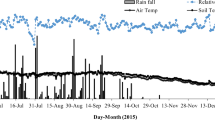Abstract
In experiments with transplanted rice (Oryza sativa L.) at the Central Soil Salinity Research Institute, Karnal, India, two methods of application of granular urea, wholly as basal dose U(W) or in splits U(S) were compared with deep, point placement (8 cm) of urea supergranules and broadcast application of two slow-release sources, sulphur-coated urea (SCU) and lac-coated urea (LCU). Comparisons were made in wet season 1984 and 1985 on the basis of ammoniacal N concentration and pH of floodwater, ammonia volatilization, rice yield and N uptake.
In 1984 the highest peak concentrations of ammoniacal N (AN) in the floodwater, > 12g m−3, and ammonia volatilization losses ≈ 54% of applied N were produced in U(W). Application of N in splits U(S) reduced peak AN levels ≈ 5g m−3 and losses to 45.1%. LCU was ineffective in reducing peak AN levels (≈ 7.5g m−3) or losses (43.6%). However SCU and USG were effective in reducing peak AN levels to < 2g m−3 and N losses to 16.9 and 3.4% respectively. Total ammonia volatilization losses as well as the initial rate of loss correlated very well with the peak levels (second day) of AN, NH3 (aq.) as well as equilibrium vapour pressure of NH3. Floodwater pH was between 9.5 and 10.0.
Split application of granular urea was generally more efficient in terms of yield and N recovery (41.4%, average of two years) as compared to whole application (29.5%). LCU was ineffective in improving grain yields or N recovery (30.9%). SCU was ineffective in improving grain yields but improved N recovery to 57.9%., USG increased grain yields only in first year by 19% over U(S) and improved N uptake to 60.5%. A negative linear relationship was established between N uptake by rice at harvest and AN levels in floodwater two days after fertilization which can be used as an index to evaluate fertilizers.
Similar content being viewed by others
References
Cao ZH, De Datta SK and Fillery IRP (1984) Effect of placement methods on floodwater properties and recovery of applied nitrogen (15N-labelled urea) in wetland rice. Soil Sci Soc Am J 48: 196–203
Cao ZH, De Datta SK and Fillery IRP (1984) Nitrogen-15 balance and residual effects of urea-N in wetland rice fields as affected by deep placement techniques. Soil Sci Soc Am J 48: 203–208
Craswell ET and Vlek PLG (1979) Fate of fertilizer nitrogen applied to wetland rice. In: International Rice Research Institute, Nitrogen and Rice, pp 175–192. Los Banos, Philippines
Craswell ET, De Datta SK, Obcemea WN and Hartantyo M (1981) Time and mode of nitrogen fertilizer application to tropical wetland rice. Fertilizer Research 2: 247–259
Fillery IRP and Vlek PLG (1986) Reappraisal of the significance of ammonia volatilization as an N loss mechanism in flooded rice fields. Fert Res 9: 79–98
Rao DLN and Batra L (1983) Ammonia volatilization from applied nitrogen in alkali soils. Plant and Soil 70: 219–228
Rao DLN and Batra L (1984) Evaluation of conventional, slow-release and nitrificationinhibitor-treated fertilizers for rice in an alkali soil. International Rice Res Newsletter 9(5): 26–27
Rao DLN and Ghai SK (1986) Effect of phenylphosphorodiamidate on urea hydrolysis, ammonia volatilization and rice growth in an alkali soil. Plant and Soil 94: 313–320
Simpson JR, Freney JR, Wetselaar R, Muirhead WA, Leuning R and Denmead OT (1984) Transformations and losses of urea nitrogen after application to flooded rice. Aust J Agric Res 35: 189–200
Vlek PLG and Stumpe JM (1978) Effect of solution chemistry and environmental conditions on ammonia volatilization losses from aqueous systems. Soil Sci Soc Am J 42: 416–421
Vlek PLG and Craswell ET (1979) Effect of nitrogen source and management on ammonia volatilization losses from flooded rice-soil systems. Soil Sci Soc Am J 43: 352–358
Vlek PLG and Craswell ET (1981) Ammonia volatilization from flooded soils. Fert Res 2: 227–245
Author information
Authors and Affiliations
Rights and permissions
About this article
Cite this article
Rao, D.L.N. Slow-release urea fertilizers — effect on floodwater chemistry, ammonia volatilization and rice growth in an alkali soil. Fertilizer Research 13, 209–221 (1987). https://doi.org/10.1007/BF01066445
Accepted:
Issue Date:
DOI: https://doi.org/10.1007/BF01066445




